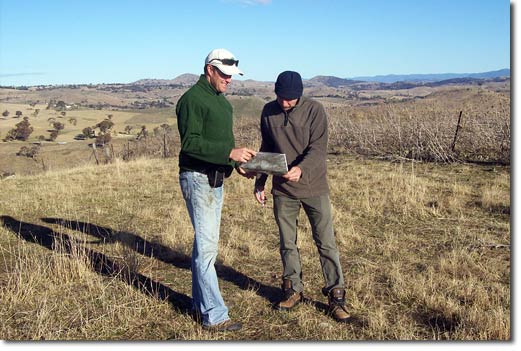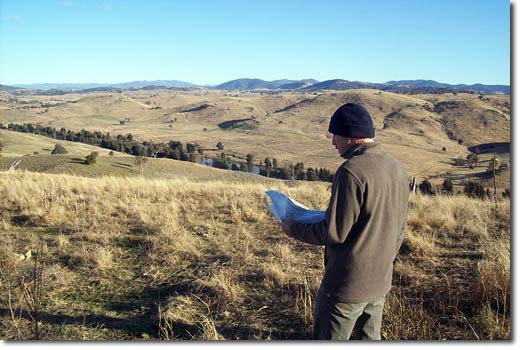


|
Joined:
|
02/02/2011 |
|---|---|
|
Last Updated:
|
09/02/2011 |
|
Location:
|
Tarago , New South Wales, Australia |
|
Climate Zone:
|
Cool Temperate |
|
Gender:
|
Male |
(projects i'm involved in)
(projects i'm following)
Back to Nick Huggins's profile
Posted by Nick Huggins over 12 years ago
by Nick Huggins

I just purchased a farm in the New South Wales Southern Tablelands, 30min south of Goulburn and 50min east of Canberra, the Australian Capital, and a good friend of mine and of permaculture, David Spicer, has set his sights on the development of his consultancy business in the town of Tumut at the base of the Snowy Mountains, NSW. In moving to a new bio-region there is also an element of adjustment and making yourself known to the good people within it. As such, David and I have set ourselves individual goals that overlap so that we can both compliment each other’s skill sets to take permaculture to our wider communities.
With my current work load going through the roof, I have enlisted David’s help to clear my current back log of broad acre permaculture designs commissions that have been piling up on my desk. It is incredible how much work for permaculture consultants there is out there at the moment, from people who really want to make a change in their lives and also in some way help repair Gaia and set up there own regenerative human habitat.
On Friday 15th July, 2011, David and I spent a fine sunny day walking the entire 2000 acres of a worn out sheep property at the foothills of the eastern side of the Snowy Mountains, NSW. Below I have included the client’s brief to us.
Essential elements of an effective long-term plan
1) Plan should include topographical, soil, water flow, existing vegetation, existing infrastructure, climate and information to show where the following exist and where they should and could be:
a) tree lots and swale lines (specifying ripping vs hay bales), and also areas of scattered trees
b) dams
c) fence lines
d) other infrastructure such as sheds and houses
e) cultivatable areas
f) labor force required2) How will each of the following be addressed in the short (3 yr) medium (5 yr) and long-term (10 yr):
- Pasture improvement — including replacing fertilized with native pasture, tree forage, specific strategies for weed control, eg. thistles. We need something quantifiable in terms of dry sheep equivalent carrying capacity.
- Water supply — replacing access to creeks with dams, adding capacity for possible irrigation for orchard and some other areas.
- Soil improvement — depth, type, acidity, carbon — what results can be expected in which areas? Can we sell carbon credits?
- Revegetation — focusing on local natives as appropriate, using some non-native species for forage, placing plantings in the landscape in an effective way (for fire safety, erosion control, stock management, and to enhance existing trees). We need specific figures on how much land will be removed from the leases for regeneration.
- Biodiversity — we have a list of local birds, mammals, reptiles, and amphibians. Some species we may want to specifically attract, such as the Superb Parrot, Gang Gangs etc. Important to check whether new plantings will attract pest birds such as mynahs and noisy miners.
- Water quality — through slower flows of water from hills, revegetation of creek banks, ceasing aerial application of super phosphate and herbicides. We need baseline information to compare over years.
- Fire safety — plantings in relation to wind direction, proximity to houses, etc.
- Climate records — need to collect and put into a useful form.
3) One of my reasons for wanting an integrated plan was that there’s a tendency to end up with individual small areas that have minimal relation to one another — for example the existing tree lots. Also there’s a tendency after plantings to end up with a lot of straight line woodlots that are out of harmony with the landscape.
We need to divide the results of the plan into manageable projects over a number of years, starting with 1-2 projects for this calendar year.
We already know of three projects that could go ahead:
- The steep slope above the cutting on Esdale — to be fenced, new grid in the road.
- The steep slopes that form part of the L-shaped paddock facing Mullion Creek — trees should be fenced out from stock. No need for access to water.
- The windbreak on the Adnamira side is degenerating fast and performs a useful function. On the north side of the windbreak the steep slope is prone to erosion and should be a priority for improvement — just not sure how this works with keyline style plantings.
- The further project of fencing out Mullion Creek to avoid having floodgates requires building dams to provide an alternate water source.
Issues
- Degradation of Land/Soil
- Loss of biodiversity
- River and creek water quality
- Long-term income vs. potential money-pit
Aims of long-term plan
- Improve and stabilise soil
- Improve value of land for grazing
- Improve drought tolerance, reduce winter feeding requirements, make adaptable to future climate change
- Improve water quality
- Maintain privacy and quality of life for living at Esdale
- Improve conditions for native fauna through bushland restoration
- Find additional ways of earning income from land to ensure long-term income — including niche agricultural projects and possible eco tourism use of river
- Provide a resource for others interested in researching/studying/benefiting from what is learned here.
Opportunities are all around us. If this is the sort of career you would like to include in your permaculture life, then get yourself out there and get yourself known. Write articles for local papers, speak about permaculture on local radio (like David did last week) and/or book yourself in for the Urban Permaculture Landscape Design course on October 31, 2011. During this intensive 5-day Permaculture Urban Landscape Design course, students will learn the fundamentals of running a professional permaculture design and consultancy business.
This is a hands-on learning experience, from the ground up. You will be able to: manage contractor bidding and installation of the design on behalf of the client; produce concepts and plans for urban, rural and aid projects; learn about proper selection of plants, softscaping, hardscaping, costing and estimation; and have the opportunity to learn the fundamentals of design, implementation and execution in several real life environments.
There are people out there screaming for permaculture trained professionals to help them plan their human habitats.
See you in October at the PRI.

You must be logged in to comment.

| Internship |
| Type: Internship |
| Teacher: Geoff Lawton |
| Location: Zaytuna Farm |
| Date: Jan 2010 |

| Earthworks Course |
| Type: Earthworks |
| Teacher: Geoff Lawton |
| Location: Zaytuna Farm |
| Date: Jan 2010 |

| Aid Worker Course |
| Type: Aid Worker |
| Teacher: Geoff Lawton |
| Location: Zaytuna farm |
| Date: Mar 2010 |

| Permaculture Design Teacher Training Course |
| Type: Teacher Training |
| Teacher: Geoff Lawton |
| Location: Zaytuna Farm |
| Date: Mar 2010 |

| Diploma Horticulture |
| Type: Gardening |
| Teacher: John O'Donohue |
| Location: Australian Institute of Horticulture |
| Date: Oct 2001 |

| Certificate III Landscape Design |
| Type: Gardening |
| Teacher: John O'Donohue |
| Location: Australian Institute of Horticulture |
| Date: Feb 1999 |

| Permaculture Design Course |
| Type: Permaculture Design Certificate (PDC) course |
| Verifying teacher: Geoff Lawton |
| Other Teachers: Peter Brecknock |
| Location: Zaytuna Farm |
| Date: Nov 2009 |

| Keyline Design Course |
| Type: Other |
| Teacher: Darren J. Doherty |
| Location: Milkwood Permaculture |
| Date: Oct 2010 |

| RegenAg Local Farms & Community |
| Type: Other |
| Verifying teacher: Nick Ritar |
| Other Teachers: Joel Salatin |
| Location: Mulloon Creek - Natural Farms |
| Date: Nov 2010 |

| Soil Biology / Compost Course |
| Type: Soil Biology/Compost |
| Teacher: Paul Taylor |
| Location: Zaytuna Farm |
| Date: Feb 2010 |
| 5 PDC Graduates (list) |
| 0 PRI PDC Graduates (list) |
| 46 Other Course Graduates (list) |
| have acknowledged being taught by Nick Huggins |
| 1 have not yet been verified (list) |
| Nick Huggins has permaculture experience in: |
|---|
| Cold Temperate |
| Cool Temperate |
| Warm Temperate |
| Mediterranean |
| Island |
| Sub tropical |
| Dry Tropical |
| Cold Desert |